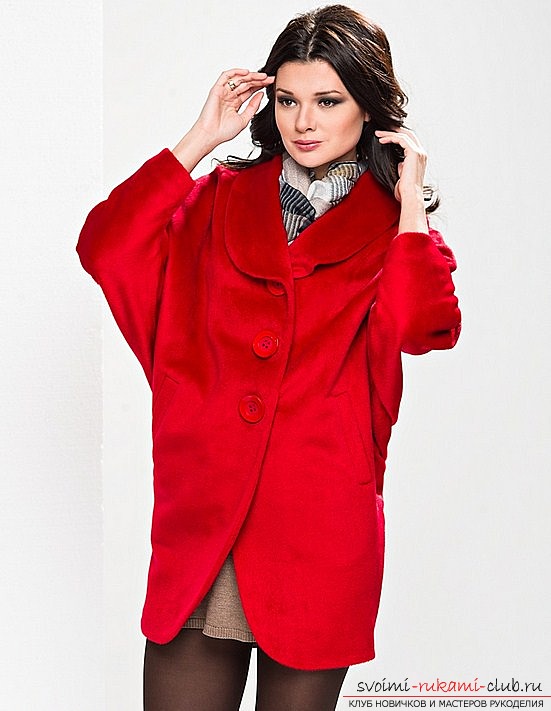
How to sew a fashionable coat with one-piece sleeves with your own hands. Pattern of a coat with an instruction for sewing
A distinctive feature of this coat is that,that opening of the front half of the sleeve is carried out together with the front, and the ulnar - with the back half. Sleeves include two lines. On top of the connecting line, as if continuing the seam on the shoulders, and from below - flowing into the line on the side. For the freedom of movement, crotches with a diverse appearance are attached.  Elements of nesting. The distinctive features of the elements of this unique clothing from the main material are shown in the figure.
Elements of nesting. The distinctive features of the elements of this unique clothing from the main material are shown in the figure.  The elements of the lining are covered in the form of the elements of the top.
The elements of the lining are covered in the form of the elements of the top.  First, you need to process the transfer andback with a steamer so that the fabric is perfectly prepared. After sewing the darts, we start the heat transfer. The front halves are pressed in the area of the thorax, then we pull the edges to the top of those parts of the sleeves that are on top for a good fit of the arm. To achieve this, the front halves put the face inwards, combining the available slices, and maximally stretch the sections at the top of the sleeves, starting from the shoulder itself, but not reaching the elbow point about 6 cm. Together we press the resulting slack material on the area of sewing the sleeve into the armhole. The cuts below are delayed to create a curvilinear contour into the inside of the sleeve. Depends on the type of hoses and properties of the material, how we will maintain the shape, the elements are disconnected and all the elements are bent along the face inward and in addition we pull the cuts along the ulnar line, and in the bending place - we pry. In the same way, we perform processing on the back half. Having made a moist - heat treatment in the area of the armhole armhole on the side of the front and back halves, we lay the edge and spend it with an inconspicuous stitching.
First, you need to process the transfer andback with a steamer so that the fabric is perfectly prepared. After sewing the darts, we start the heat transfer. The front halves are pressed in the area of the thorax, then we pull the edges to the top of those parts of the sleeves that are on top for a good fit of the arm. To achieve this, the front halves put the face inwards, combining the available slices, and maximally stretch the sections at the top of the sleeves, starting from the shoulder itself, but not reaching the elbow point about 6 cm. Together we press the resulting slack material on the area of sewing the sleeve into the armhole. The cuts below are delayed to create a curvilinear contour into the inside of the sleeve. Depends on the type of hoses and properties of the material, how we will maintain the shape, the elements are disconnected and all the elements are bent along the face inward and in addition we pull the cuts along the ulnar line, and in the bending place - we pry. In the same way, we perform processing on the back half. Having made a moist - heat treatment in the area of the armhole armhole on the side of the front and back halves, we lay the edge and spend it with an inconspicuous stitching.  Combining the slices on the sides of the coat and cuts along thethe bottom of the sleeves. In this model of the coat, without the crotch of the gusset, the seams on the sides and at the bottom of the sleeves are processed together. To do this you need to fold the front halves with the back face to each other, combine the slices and the signs of control. We sew the sections on the sides of the back part manually (stitches of 20 mm) and together we grind the edges of the sleeves with the elbow portion of the sleeve at the height to the elbow. After cutting, we spread out at a height of 10 mm from the piercing line, and iron the lines.
Combining the slices on the sides of the coat and cuts along thethe bottom of the sleeves. In this model of the coat, without the crotch of the gusset, the seams on the sides and at the bottom of the sleeves are processed together. To do this you need to fold the front halves with the back face to each other, combine the slices and the signs of control. We sew the sections on the sides of the back part manually (stitches of 20 mm) and together we grind the edges of the sleeves with the elbow portion of the sleeve at the height to the elbow. After cutting, we spread out at a height of 10 mm from the piercing line, and iron the lines.  Combination of gaps with a coat. These pieces of clothing are in the form of a diamond or a square, all-in-one with a part of the sleeve. Also there are gussets with a detachable sidewall half of the product. The area of the undercut intended for the crotch is laid with a cotton strip, attaching it from the underside along the edges along the height of 3-5 mm. In clothes made of materials with high repellency, before sewing the gusset, it is necessary to process the corners of the edges on the front and back, laying out the c / w patch with the material, performing cutting in the form of a right angle. Obtachka is made by a width of 20-30 mm and a length that is equal to the incisions of the gussets. The obtack is attached to the outside by a stitch with a width of 7 mm, and by the end it is only 2 mm. After this, it is necessary to bait and after that we spread to the undercut the gusset near the stitching line. The other part of the crotch is swept and sewed, performing the processing of lines on the sides and from below, and we do the same as the first. The lines of the gusset are ironed when ironing the seams on the sleeves on the side and below. For the reliability of alignment, the corners of the cuts are traced from the face along the front and back halves 2 mm high from the line of crotch laying, with a length of about 3 cm from all sides of the undercut angle. We spend with threads from silk, suitable on color scale to a material. If you perform a separate treatment of the bottom and the lateral line of the sleeve, the crotch in the form of a diamond is sewn into a closed incision. Sewing and ironing in the corners is done in the manner described above.
Combination of gaps with a coat. These pieces of clothing are in the form of a diamond or a square, all-in-one with a part of the sleeve. Also there are gussets with a detachable sidewall half of the product. The area of the undercut intended for the crotch is laid with a cotton strip, attaching it from the underside along the edges along the height of 3-5 mm. In clothes made of materials with high repellency, before sewing the gusset, it is necessary to process the corners of the edges on the front and back, laying out the c / w patch with the material, performing cutting in the form of a right angle. Obtachka is made by a width of 20-30 mm and a length that is equal to the incisions of the gussets. The obtack is attached to the outside by a stitch with a width of 7 mm, and by the end it is only 2 mm. After this, it is necessary to bait and after that we spread to the undercut the gusset near the stitching line. The other part of the crotch is swept and sewed, performing the processing of lines on the sides and from below, and we do the same as the first. The lines of the gusset are ironed when ironing the seams on the sleeves on the side and below. For the reliability of alignment, the corners of the cuts are traced from the face along the front and back halves 2 mm high from the line of crotch laying, with a length of about 3 cm from all sides of the undercut angle. We spend with threads from silk, suitable on color scale to a material. If you perform a separate treatment of the bottom and the lateral line of the sleeve, the crotch in the form of a diamond is sewn into a closed incision. Sewing and ironing in the corners is done in the manner described above.  Our coat with a one-piece sleeve is ready!
Our coat with a one-piece sleeve is ready!




